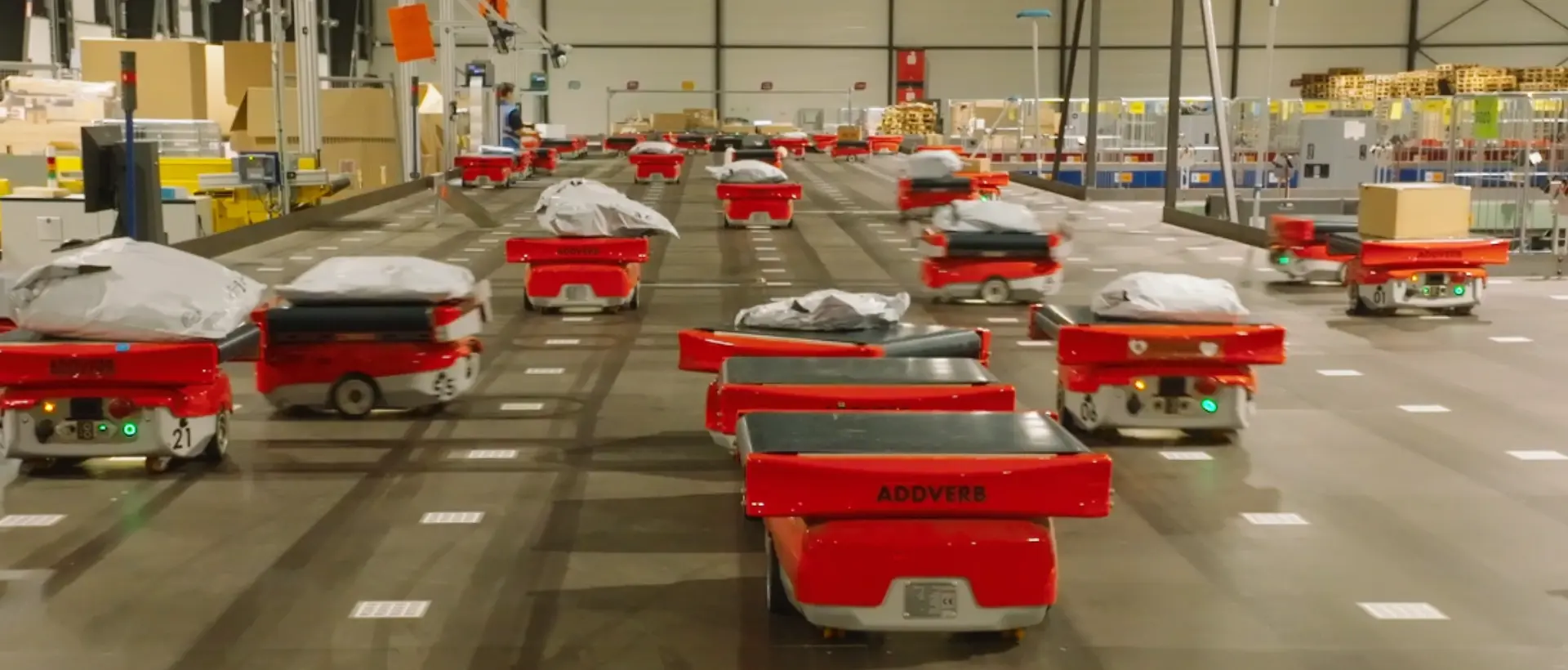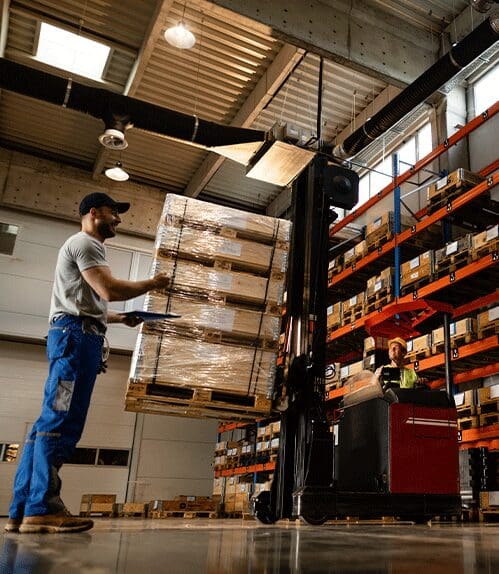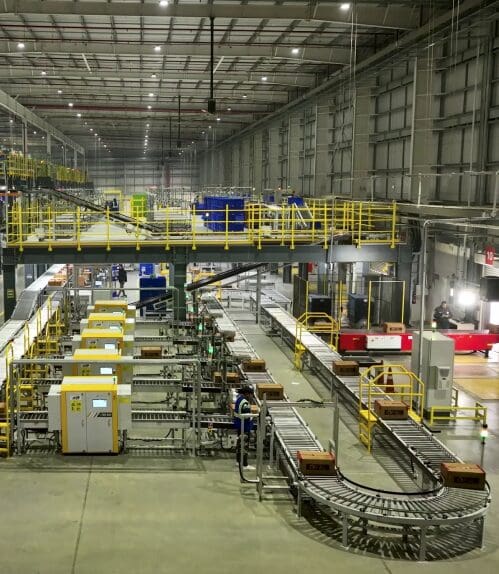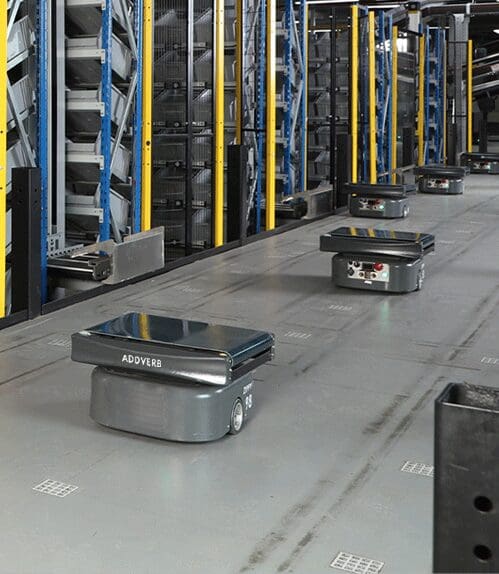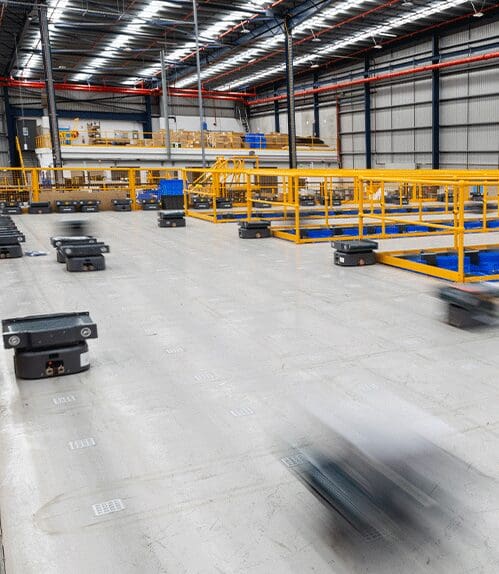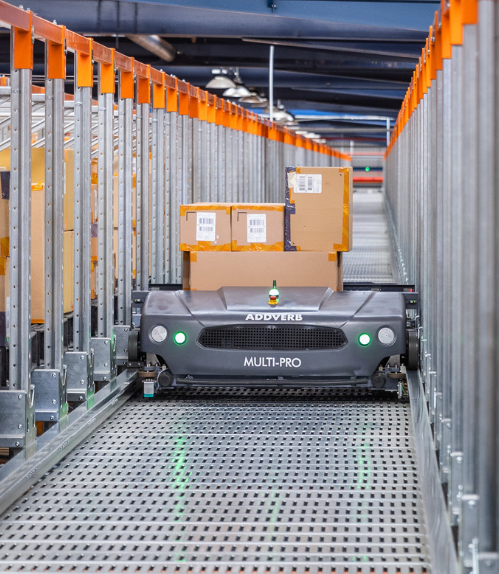Inhaltsübersicht
Addverb’s Fleet Management System manages congestion on the warehouse floor by intelligently coordinating robotic traffic to ensure smooth and efficient operations. As the fleet of robots grows from dozens to hundreds, maintaining the fluidity of traffic, without collisions, delays, and deadlocks, remains one of the most difficult aspects of warehouse automation. Even the best robotic fleets, if they are not monitored and managed intelligently, may suffer from throughput inefficiencies, from the loss of operations or inevitable deadlocks. So how does Addverb’s Movect, a Fleet Management System (FMS), coordinate that precision of movement? Let’s see how it creates efficiency from chaos.
While traffic on highway just gets you late to work, traffic for your robotic fleet can have much deeper consequences.
Expanding at 16.5% CAGR, the global fleet management market is expected to jump from a value of US$ 65.1 billion in 2024 to US$ 300 billion by the end of 2034.
The Challenge: Congestion in Automated Warehouses
In modern warehouse operations, robots are ubiquitous – sorting, picking, transferring, and charging in several zones. Initially, deploying more robots was a logical path for higher throughput. However, as we learned with one of India’s largest eyewear brands, more robots do not always mean higher productivity.
When we kept increasing the count of robots in our fleet of robotic sorters – zippy, we saw an increase in the throughput initially, however, it didn’t last . With an increase in the number of robots, the system began to struggle with traffic congestion. Robots began to queue up in confined spaces, inhibiting each other’s movement and causing a decrease in the overall efficiency of the system. The warehouse reached the tipping point, where additional robots resulted in slower throughput.
Managing robotic congestion is as important as managing the number of robots. That is why Addverb’s Movect became integral part of their robotic fleet orchestration.
The Movect Solution: Zone-Based Congestion Control
Addverb’s Movect FMS addresses traffic through a feature called Zone-Based Fleet Control, which is a smart logic system that creates smaller, manageable zones for the warehouse. Each zone is defined by three or more connection points (nodes), which can be monitored to govern robot movements.
In each zone, Movect continually manages traffic with up-to-date information about how many robots are in the zone, their flow direction, and the overall operational load of that zone. The end result is a flexible, intelligent traffic network that functions as a digital highway-like system. Movect uses predetermined conditions in each zone to maintain the zones’ flow. If four or more robots from a zone are trying to exit from the same direction, then the FMS automatically re-routes the rest of the incoming robots to alternative zones or paths, just as a GPS might re-route vehicles to avoid traffic jams. This logical control keeps traffic from developing into a deadlock and ensures consistent throughput during peak traffic times.
The Traffic Light System: Smarter Flow Control
At the core of all Movect’s congestion management rests its Traffic Light System, an innovative rule-based control system. Movect’s user interface allows engineers to set virtual traffic lights on the warehouse map at various key nodes.
These lights will control the inflow and outflow of robots in real-time with the use of configurable conditions:
• Number of robots in a queue, or in a zone
• Area and density in a zone
• Operational timing, or urgency to perform the task
With only one click, both one-way and two-way traffic lights can be implemented, which help in controlling the flow of traffic on one or both sides. This provides very specific control over movement patterns, which keeps robots from clustering in high-demand areas or colliding in cross-sections. In the eyewear case study, simply adding traffic lights to only five key nodes resulted in a substantial operational improvement. Movect’s logic ensured that when a zone contained four or more robots in queue, other robots would automatically use alternative routes, reducing wait times and eliminating congestion hotspots, resulted in a significant increase in throughput.
The Impact: 85% Higher Throughput
Movect is also proactive in its congestion management approach through real-time heat maps of robot activity. This visual representation of the facility creates an opportunity for warehouse managers to quickly assess which zones that suffer from congestion and to act.
With a colour-coded display, practitioners are able to see the density in areas of activity and to make educated, yet quick, decisions to make the warehouse effective and efficient (i.e. re-routing the flow of tasks or pick/drop points).
Real-Time Visualisation: Seeing Congestion Before It Happens
Movect is also proactive in its congestion management approach through real-time heat maps of robot activity. This visual representation of the facility creates an opportunity for warehouse managers to quickly assess which zones that suffer from congestion and to act.
With a colour-coded display, practitioners are able to see the density in areas of activity and to make educated, yet quick, decisions to make the warehouse effective and efficient (i.e. re-routing the flow of tasks or pick/drop points).
Simulation and Scenario Testing
A key feature of Movect is its ability to simulate. Even before applying a new traffic rule or layout, warehouse engineers can simulate it.
In the graphical interface, users can:
• Specify a new pick-up, drop-off, or charge location.
• Test multiple configurations for zones.
• Experiment with the congestion control rules.
• Compare the throughput rate between different rules.
This simulated environment enables teams to optimise their floor layout without disrupting daily operations. Each scenario is data-driven, which allows teams to feel safe and confident in their capacity to use the system. Once implemented, Movect can report on each performance characteristic of interest using throughput graphs and congestion heatmaps, and provide complete transparency as to how each rule directly impacts performance.
Learning from the Past: The Replayer Advantage
Movect’s congestion management extends beyond live monitoring and simulation; it also includes the ability to recreate and analyse past events.
The Replayer feature, developed during a remote implementation in France, acts like a “CCTV for robot operations.” It reconstructs every robot’s movement from log data, allowing engineers to see exactly how and where congestion formed.
This capability reduces troubleshooting time drastically, as Addverb’s team reported, the Replayer cut diagnostic time by 10x, helping identify root causes of slowdowns within minutes. It’s a crucial feedback tool that closes the loop between observation and optimization.
Conclusion: Addverb’s Fleet Management System Manages Congestion
Warehouse automation is no longer only about deploying additional robots in a warehouse, but also configuring them in an intelligent manner. Movect congestion management takes robot coordination to another level of intelligence by deciding on the fly for each turn, pause, and reroute.
Through zone-based traffic control, virtual traffic lights, heatmaps, and simulation capability, Movect turns a busy warehouse floor into an integrated system of motion. As a result, it enables faster fulfilment and an overall more balanced, predictive, and efficient warehouse ecosystem.
In a world where milliseconds matter, Movect ensures every robot moves with purpose and never gets stuck in traffic again.

